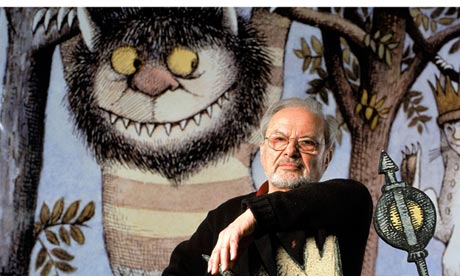The author of Where the Wild Things Are was driven to make rich, complex, even dangerous art for children

Maurice Sendak in 2002, beside a life-size
illustration from his book Where the Wild Things Are. Photograph: James
Keyser/Time & Life Pictures/Getty Images
Playwright and screenwriter Tony Kushner remembers
his friend Maurice Sendak
One morning several years
ago, Lynn Caponera, Maurice Sendak's
longtime assistant, housekeeper and best-beloved friend arrived at his home to
find him sitting on the sofa in the living room, a place in the house where he
seldom spent much time. Lynn asked him what he was doing in there. He told her
that the night before, he'd been awakened in his bedroom above by the sound of
something repeatedly striking a window. He went downstairs and discovered a bat
sitting on the sofa.
Maurice sat down beside the bat, which began to speak to him in German. It
went on and on, but he couldn't understand much of what the bat was saying
because Maurice's grasp of German was poor. When it finally paused, Maurice
asked the bat what it was talking about. It said that it had been telling him
how much it loved him.Maurice asked Lynn, "Do you believe me?"
"Yes," she replied, "somehow I do."
When Maurice asked Lynn if she believed him, was he, I wondered, asking her if she believed he'd had a nocturnal conversation with a bat? Or was he asking if she believed what was implicit in the story he was telling? Did she believe that this was how he felt love reached him: in the lonely night, in a rarely visited room, in a serenade from a chattily familiar and yet alien creature fluttered up from the cave of the unconscious, in the nearly incomprehensible, enticing, forbidden language of Mozart, Mahler and the Holocaust – and also in the language of Freud, heart's truth spoken from a couch? Was Maurice asking Lynn if she loved him, which meant that she believed enough to surrender incredulity, to step with him out of reality, into a realm of the imaginary in which, at last, he could be understood? Did she, in other words, truly believe in the august imagination? Did she believe in art?
Any seasoned visitor to the World of Sendak was accustomed to hearing its resident magician relate extraordinary events with such fluency, gravity and fervency that unless the story involved a German-speaking bat, its mere improbability never seemed a reliable standard by which to assess whether or not it had actually happened – or whether, as in the case of the bat, Maurice believed it had.
Full story here
No comments:
Post a Comment